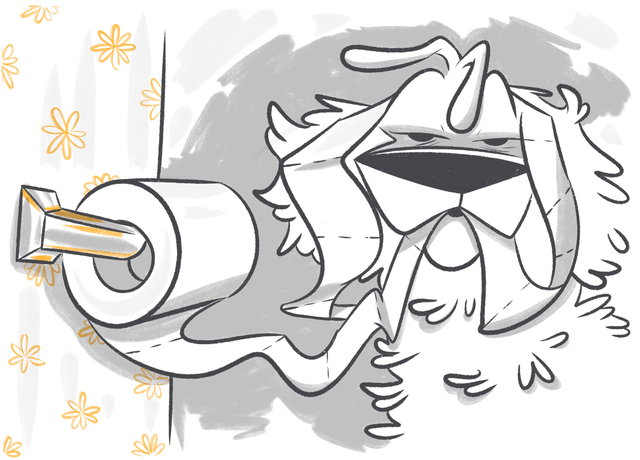It's a challenging part of pet parenting, but let's face it head-on: dealing with fecal and urinary incontinence in dogs, particularly our beloved older and female fur babies, is sometimes part of the journey.
The golden years might come with a few hiccups, but remember, with the right knowledge and resources, these issues can be managed effectively. So whether you're finding mysterious puddles around the house or dealing with unexpected messes from your female dog when she is resting, we're here to help you navigate this tricky terrain. Let's dive in.
Stop Googling - Ask a Real Vet
Content:
- Dog Urinary Incontinence
- Fecal Incontinence In Dogs
- How Can the Petcube Emergency Fund Help With Treatment
- Final Thoughts
Dog Urinary Incontinence
Urinary incontinence in dogs, particularly older ones, and often more so in females, is an issue many pet owners face. Let's take a closer look at this common problem.
Signs of Urinary Incontinence In Dogs
Canine urinary incontinence can often sneak up on you. One day, you might notice a small wet patch where your furry friend was snoozing, or you may observe your dog dribbling urine while walking. Other signs include:
- Frequent urination;
- Excessive licking of the genital area;
- Strong urine odor from your dog or their sleeping area.
Causes of Urinary Incontinence In Dogs
There are several reasons why your dog might be experiencing incontinence, but a common cause, particularly in older, spayed females, is a lack of muscle tone around the bladder sphincter. Studies show that after spaying, some females may experience a drop in estrogen levels, which affects the strength of the bladder sphincter. This can mean that they often unintentionally pee when they're relaxed or lying down.
University of Bristol research points to several other reasons for canine urinary incontinence, including:
-
Urinary Tract Infections (UTIs): Infections can irritate the bladder, causing your dog to urinate more frequently and sometimes uncontrollably.
-
Bladder Stones: These can irritate and lead to incontinence. They may also cause painful urination, blood in the urine, and other symptoms.
-
Spinal Cord Disease: Issues with the spinal cord can disrupt the nerves controlling the bladder, leading to incontinence.
-
Hormonal Imbalance: Besides estrogen, other hormone imbalances can also cause incontinence. For instance, dogs with hypothyroidism can display signs of incontinence.
-
Aging: Aging can lead to a loss of muscle control in the bladder, leading to incontinence.
-
Congenital Abnormalities: Some dogs are born with problems that affect the urinary tract and can lead to incontinence.
-
Certain Medications: Some drugs can cause increased urine production or relax the bladder sphincter muscle, leading to incontinence.
-
Neurological Problems: Conditions that affect the brain or nerves can lead to a loss of bladder control.
-
Behavioral Issues: Sometimes, what seems like incontinence may be a behavioral issue. For example, dogs might urinate in response to fear or anxiety.
If your dog is showing signs of urinary incontinence, it's important to consult with a vet to identify the cause and determine the best course of treatment. Use a pet camera on your dog to try to catch any signs of them peeing indoors so that you can have some context for when and how it happens.
Fecal Incontinence In Dogs
Signs of Bowel Control Loss In Dogs
Just like urinary incontinence, signs of fecal incontinence can include unexpected messes where your dog sleeps or rests. The most common symptom of poop incontinence is that your house-trained dog may suddenly start pooping in the house. Other signs might be that your dog has difficulty squatting or is excessively straining during defecation.
Pooping in the house is often a sign of serious health issues, with studies pointing to problems like degenerative myelopathy and intervertebral disk disease (IVDD). Essentially, it could mean that something is interfering with a dog's nervous system that tells them to keep their sphincter closed, causing them to lose control of the bowels.
In other cases, it could be the result of severe diarrhea, contagious diseases, or simply old age. So, don’t punish your dog for fecal incontinence.
Dogs with diarrhea may struggle to "hold it" and have temporary incontinence and mess in the house.
Causes of Bowel Control Loss In Dogs
Fecal incontinence can be caused by a range of issues. These include:
- Age-related muscle weakness and canine cognitive decline (doggy dementia);
- Spinal injuries;
- Neurological disorders;
- Gastrointestinal problems;
- Infectious diseases like parvo in puppies;
- Organ failure;
- Certain medications can play a part.
Importantly, issues like bowel inflammation or parasitic infections can also lead to fecal incontinence.
How Can The Petcube Emergency Fund Help With Treatments
The Petcube Emergency Fund exists to assist with unexpected pet health expenses, like those that might cause urinary and fecal incontinence. Think of sudden spinal injuries or strokes that can cause your dog to suddenly lose control of their bladder and bowels.
By offering financial aid of up to $3000 for only $1 a day, the fund can help ensure your beloved pet receives the necessary treatments in those hairy, unforeseen emergencies.
Final Thoughts
In conclusion, while urinary and fecal incontinence in dogs can be difficult to manage, remember that you're not alone in this journey. From identifying the signs to understanding the causes and seeking out resources like the Petcube Emergency Fund, it's all part of ensuring your dog's comfort and happiness. Always remember that your vet is your best ally when dealing with these issues. Don't hesitate to reach out to them when you need help.
Was this article helpful?
Help us make our articles even better









